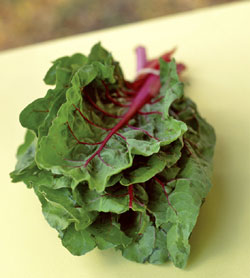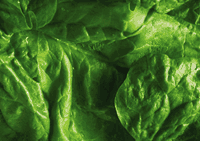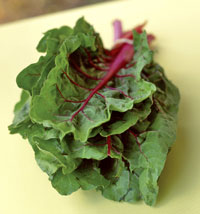The virtues of greens
by Karen Lamphere
This article was originally published in July 2005

(July 2005) — Eat more dark leafy greens! As a nutritionist, I say that a lot. And for good reason: Greens are nutritional superstars that do everything from fight cancer to protect eyesight.
Sadly, many of us walk into grocery stores and never notice or even recognize many of the dark green vegetables there. In working with clients, as well as students in my healthy cooking classes, I’m often surprised at the lack of familiarity with greens beyond the obvious choices of spinach and broccoli. So what is it about greens that make them so healthful and universally recommended?
The science of color
Throughout history, healing has been associated with the color green. In plants, the color green announces the presence of chlorophyll. The darker green a plant, the more chlorophyll it contains.
Chlorophyll is the substance in plants responsible for photosynthesis — a process allowing plants to absorb light from the sun and convert it into usable energy for storage, to be used as food for animals and humans alike. Experiments have demonstrated that chlorophyll can help prevent liver and colon cancers by binding carcinogens commonly associated with these cancers and preventing their absorption by the intestines.
To receive the full benefit of chlorophyll, avoid overcooking green vegetables. With brief steaming, the chlorophyll content of these foods is preserved, and absorption of chlorophyll from these foods may actually be increased. Consumption of green vegetables in raw form is also an excellent way to obtain the health benefits of chlorophyll.
Greens are also an excellent source of important vitamins and minerals. One B vitamin that greens are famous for is folate (think foliage). In fact, the Greek origin of the word folate means “leafy green.” Folate is critical for the proper development of the nervous system and is important during pregnancy to prevent nervous system defects such as spina bifida.
Heart disease prevention
Folate, along with vitamins B6 and B12, also helps prevent heart disease by lowering levels of homocysteine. Without folate, homocysteine levels increase in the blood, causing plaque build-up and free radical damage in blood vessel walls.
Research has shown a strong relationship between folate, homocysteine, heart disease and stroke. People with low levels of folate are more likely to develop heart disease and strokes than those with more folate in their systems.
Folate and cancer prevention
Other research has provided evidence of a link between high folate intake and reduced risk of colorectal cancer. Studies also suggest that diets low in folate may increase the risk of cancers of the breast (particularly among women who drink alcohol), cervix and lung. Just one half cup of asparagus supplies about 30 percent of the recommended daily allowance (RDA) of 400 micrograms.
Greens for strong bones
Another vitamin scarce in most foods but abundant in greens is vitamin K. The primary function of vitamin K is to regulate normal blood clotting. An additional though less known function of vitamin K is to promote the synthesis of a protein called osteocalcin, which plays a key role in building bone.
Through its effect on osteocalcin production, vitamin K aids the healing of fractures and decreases the risk of developing osteoporosis. Studies in postmenopausal women have shown that an increased intake of vitamin K results in an increase in bone formation and a slowing of bone loss. One cup of spinach provides about 120 micrograms, almost twice the RDA.
Minerals are another good reason to eat your greens. Kale, collards, broccoli, bok choy, turnip and mustard greens are wonderful non-dairy sources of bone-building calcium and are absorbed by the body as well as milk. One serving of greens contains between 75 to 250 milligrams calcium.
Other green vegetables, such as spinach, Swiss chard, and beet greens, are less effective sources of calcium. While their calcium content appears to be high, they also contain oxalic acid, which interferes with the absorption of calcium. But this is not a reason to avoid them. They still supply the aforementioned vitamins and other crucial minerals.
Greens are also one of the best sources of magnesium, which aids calcium absorption, and are rich in other minerals such as iron, potassium, phosphorus and zinc, as well as trace minerals.
Greens: a phytochemical cocktail
Greens have much more to offer beyond vitamins and minerals. Experts estimate a single serving of greens provides more than 100 different phytochemicals. Romaine lettuce and darker green leafy vegetables such as spinach, Swiss chard, kale, collard greens, mustard greens and turnip greens contain the carotenoids alpha and beta-carotene, as well as their carotenoid cousins lutein and zeaxanthin.
It was once thought that the only significant function of carotenoids was to help prevent vitamin A deficiency. Certain carotenoids are called provitamin A compounds because the body can convert them to retinol, the active form of vitamin A, important for immune function, skin health and vision.
Recently, however, nutritional researchers have shown that carotenoids are powerful free radical scavengers. Free radical molecules can initiate cancer by damaging cell DNA. Scientists also have found that lutein and zeaxanthin migrate to the eyes’ lenses, working to block sunlight’s oxidative damage, preventing vision-clouding cataracts as well as slowing the development of macular degeneration, a leading cause of age-related blindness.
It is important to note, however, that carotenoids are better absorbed by the body in the presence of fat. A recent study showed that salads eaten with fat-free salad dressing resulted in essentially no absorption of antioxidant carotenoids, whereas substantially more carotenoids are absorbed when salads were consumed with full-fat dressing.
So, to get the most cancer-protective antioxidant punch from your salad, either use a dressing made from a healthy fat, such as extra-virgin olive oil, or add some avocado slices or chopped nuts, which have built-in sources of healthy fats.
The detoxifying power of greens
Helping our body rid itself of the myriad environmental toxins we are increasingly exposed to can help to prevent or interrupt the development of cancer. It is common knowledge that eating a diet high in fresh fruits and vegetables is cancer preventive. But certain dark green vegetables offer arguably the most powerful advantage.

Watercress, arugula, bok choy, Brussel sprouts, broccoli, rapini, collards and kale are members (among others) of the brassica, or cruciferous, vegetable family. These superfoods supply a compound called indole-3-carbinol that aids in estrogen metabolism, possibly helping to protect against hormone-dependent cancers, such as prostate and breast cancer.
One study compared the diets of postmenopausal women diagnosed with invasive breast cancer with women of the same age without breast cancer. Although the study found no relation between total fruit and vegetable consumption and breast cancer risk, women consuming an average of 1 1/2 servings of cruciferous vegetables daily had a 25 percent decreased risk of breast cancer. A recent Johns Hopkins study followed 6,100 people for 28 years and found that an average of four weekly servings of cruciferous vegetables reduced the risk of dying from any cause by 26 percent.
Supporting healthy liver function is an important cancer prevention strategy due to the liver’s key role in detoxification. Sulforaphane, another widely researched phytochemical found in cruciferous vegetables, promotes the activity of the liver’s detoxification enzymes, helping to neutralize carcinogenic chemicals and clear them from the body. As a result, there is less opportunity for the carcinogens to interact with individual cells and damage their DNA.
Another phytochemical, sinigrin, also stimulates the liver’s detoxification enzymes. In addition, it also stimulates apoptosis, a natural process during which cells in the body whose DNA has been damaged by a carcinogen self-destruct.
What about supplements?
So why not just take a supplement containing these antioxidant phytochemicals? It’s the cocktail of phytochemicals found in a varied diet that is so beneficial. When you eat a diet rich in a diverse range of vegetables you gain protection against many different types of cancer and other diseases. There are hundreds and possibly thousands of these compounds with a whole range of mechanisms that are still barely understood. What the research does tell us is that vegetables, especially the green variety, are essential for health.

So, now that you’re (I hope) convinced of the virtues of green foods, just how do you go about adding more of them to your diet? For starters, it’s wise to consume some combination of both raw and gently cooked greens.
Salads prepared with a mix of organic baby spinach and romaine, with a handful of arugula or watercress tossed in for a peppery bite, makes for a simple and refreshing summer meal. Add some feta, toasted walnuts and raspberry vinaigrette, and you’re sure to absorb those antioxidants.
Or lightly sauté kale leaves in olive oil and minced garlic. Add some currants and toasted pine nuts, then season with balsamic vinegar, salt and pepper.
Bok choy or rapini are great additions to stir-frys, along with shiitake mushrooms, Napa cabbage, tofu and an assortment of veggies. Lots of cancer-fighting power here!
Milder greens, such as spinach or chard, are easily added to scrambled eggs, frittatas, pastas and pasta sauces, sandwiches; they’re even good tucked into enchiladas. These are great ways to get some green into your kids’ diets.
The abundance and variety of greens available at the farmers markets and natural food markets this time of year provides a timely opportunity to expand your repertoire and experiment with some new flavors that may not only prevent disease, but may even extend your life! What do you have to lose?
Karen Lamphere, MS, CN, is a nutritionist in private practice in Edmonds and a PCC Cooks instructor. She holds a masters degree in nutrition from Bastyr University and can be contacted via her Web site at www.wholefoodsnutrition.com, or by calling 425-218-2310.
